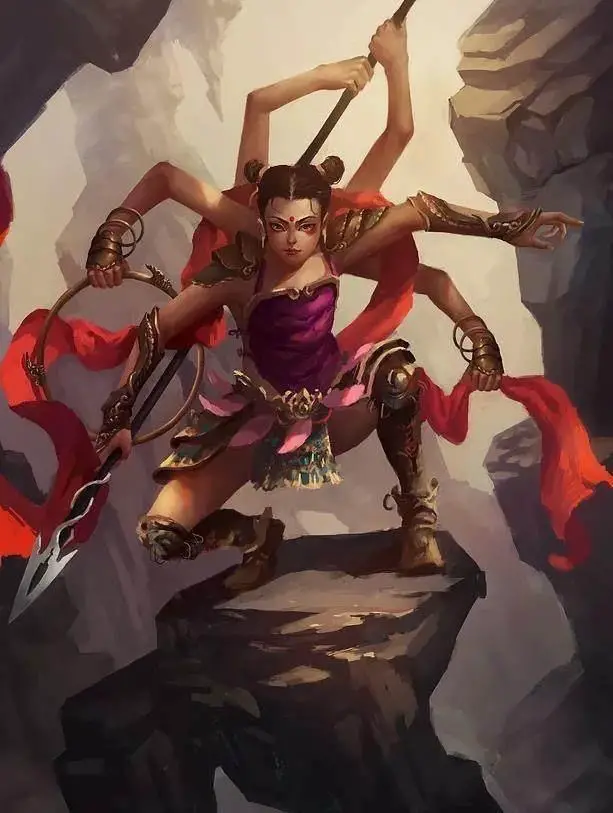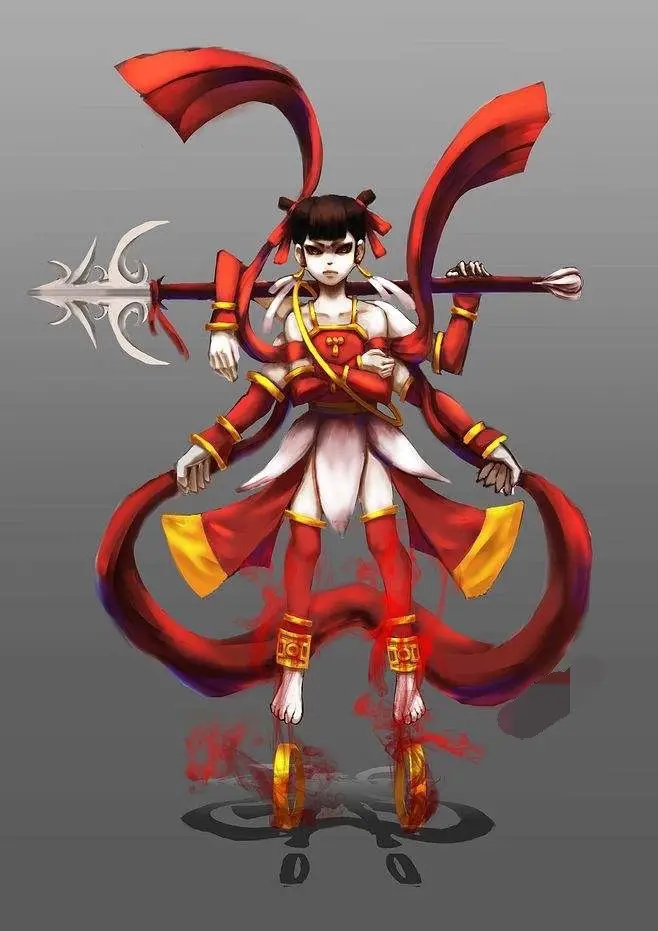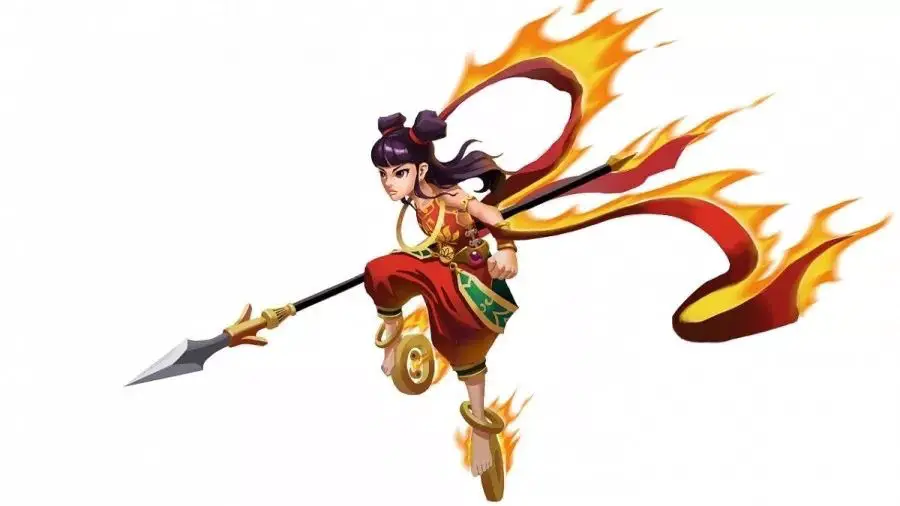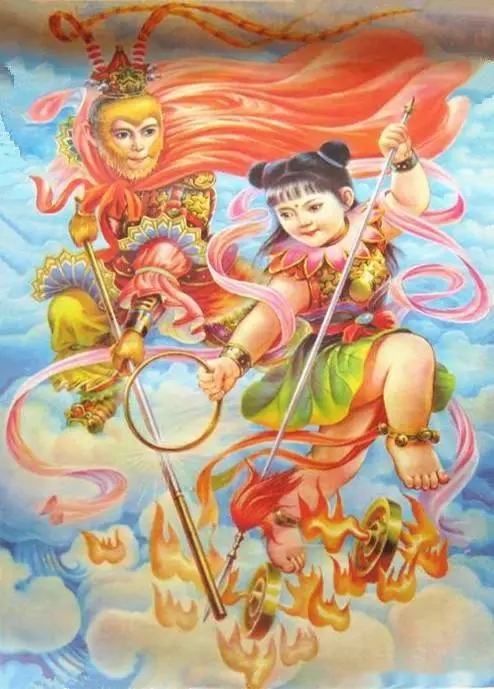Although not popular in Western countries, Nezha is a legendary figure in Chinese households. Nezha is featured in Chinese mythology and famous Chinese movies, music, classical novels, and techno dances. If you’ve never heard of this Chinese household name, this post is your opportunity to learn everything about him. Here you’ll learn about Nezha’s birth, birthplace, family, history, and death, so stick around until the end of the article.
Who was Nezha?
Nezha, also known as Na Zha, is a popular character in Chinese mythology and folklore. He is often depicted as a young boy with three heads and six arms, riding on a fiery wheel or lotus pod, and wielding weapons such as a spear, sword, and wind-fire wheels. According to legend, Nezha was born as a result of a heavenly pearl that was swallowed by his mother, who became pregnant with him for three years before giving birth to him. Nezha was known for his bravery and martial arts skills, and was often called upon to defend the people against demons and other supernatural beings. He is considered a protector of children, and is widely revered in China and other parts of East Asia.

Who was Nezha’s father?
Nezha’s father was a renowned military commander during the Shang Dynasty, known as Li Jing, who later became a Chinese god in Chinese folk religion by the title “Pagoda-wielding Heavenly King.”
Nezha’s mother was Lady Yin, also known as Yin Wuming, who, according to ancient Chinese legend, was the reincarnation of Jade Emperor’s second daughter. Unlike his father, Lady Yin was known for being lenient with Nezha and always protected and defended her son no matter what he did.
Nezha also had siblings, two brothers, Jinzha and Muzha. Jinzha was a disciple of Wenshu Guangfa Tianzun, a superior man at the time, while Muzha was Master Sangha’s apprentice.
What is Nezha’s past life?
Nezha’s past life was the Lingzhu stone, which was a piece of stone left over from Nüwa’s creation of the world. It collected the spiritual energy of heaven and earth and the essence of the sun and moon at the Tianchi pool on Mount Kunlun, becoming a sentient gem. However, there are two versions of Lingzhu’s subsequent identity. One is that he was a guardian child sent by Nüwa to save the world, and the other is that he was the “Mixed Yuan treasure pearl” of the founder of Taoism.
In the first version of the legend, Lingzhu was originally a guardian child under the seat of Nüwa. When the lustful and lecherous King Zhou of Shang showed disrespect towards Nüwa, she became furious and sent Lingzhu to be reincarnated as Nezha to punish the foolish monarch. In the end, with the help of the seductive Daji, Nezha helped to overthrow the Shang dynasty and assist in establishing the Zhou dynasty.
In the second version of the legend, Lingzhu was originally owned by the Heavenly Venerable of Primordial Beginning, but later became the disciple of the Daoist Golden Immortal Taiyi. Under the incompetent rule of King Zhou, Lingzhu followed the orders of Yu Xu and was reincarnated as Nezha under the tutelage of Li Jing at the Chen Tang Pass. After being carried in the womb of Lady Yin for three years and six months, Nezha was born from a flesh ball. He then fought against dragons in the sea and helped overthrow King Zhou, ultimately achieving great success and ascending to godhood.
Was Nezha a boy or a girl?
Nezha was a boy, the third-born son of Li Jing and Lady Yin. In Chinese legend, Nezha is frequently depicted as a teenage boy or young man, not a child. He is known for his military bun, wind fire wheels, the Universe Ring, and the Red Armillary Sash around his shoulder. He is usually holding a fire-tipped spear in his right hand. Some legends depict him with three heads and six arms.
How old was Nezha?

Nezha’s exact age isn’t known; however, according to ancient Chinese legend, Nezha existed sometime between 1600 and 1050 BCE, during the Shang Dynasty, some 3000 to 4000 years ago. Nezha is usually depicted as a teenage boy in novels, stories, and movies.
When was Nezha born?
Nezha was born during the Shang Dynasty, between 1600 and 1050 BCE, to a famous military commander, Li Jing and Lady Yin. It is said that Nezha was born at Chentang Pass with superhuman abilities and under very unusual circumstances. Chinese legend says that Nezha’s mother had been pregnant with Nezha for three and a half years, and he was born with the ability to speak. Some Chinese legends say Nezha’s birthday was on the 8th day of the 4th lunar month.
how was Nezha born
In the novel “Fengshen Yanyi”, Nezha’s birth story goes like this: His mother was pregnant for three years and six months before she went into labor, giving birth to a flesh ball. Nezha’s father, Li Jing, thought that his wife had given birth to a monster and slashed at the flesh ball with his sword. As a result, he split open the flesh ball and Nezha emerged from inside. Li Jing was unhappy, but a Daoist named Taiyi congratulated them and named the child Nezha, taking him as his disciple and presenting him with two treasures: the Qiankun Ring and the Hun Tian Ling.
Neha weapons
The Fire-tipped Spear, also known as the Purple Flame Serpent Spear Fire-tipped Spear, is a weapon used by the Chinese mythical figure Nezha in the Ming Dynasty novel “Fengshen Yanyi” and in legend. The spearhead resembles a flame and can spew fire, the spear shaft is over 6 feet long and can change shape at will. There are two of these spears that can be combined into one, with the other end being a serpent spear blade. It is an extremely rare divine weapon and was the third treasure bestowed upon Nezha by the Taoist sage Taiyi. It is a primary melee weapon used for slaying demons and monsters, and has formidable power, rivaling that of the Xuanyuan Sword. It is capable of both offense and defense, and can be used for both single combat and group attacks, with its own unique spear techniques. Nezha wields one in each of his six arms in his three-headed and eight-armed form.
The Wind Fire Wheels are another one of Nezha’s famous treasures in Chinese mythology. The two wheels produce the sounds of wind and fire as they spin, and can emit gusts of wind and flames from their left and right sides, hence their name. This pair of treasures was also passed down to Nezha by Taiyi, and they can be used as flying devices when stepped on with both feet. They also serve as auxiliary weapons for Nezha during aerial combat, similar to a mount. When ridden, they can be activated with a spell, igniting the wheels and producing wind beneath the feet, allowing Nezha to fly and fight with incredible speed and freedom, traversing both land and sky. Nezha can also control the direction and speed of the wheels while in flight by using special symbols and spells. They are typically used in conjunction with the Fire-tipped Spear.
how strong is Nezha
Nezha’s status in the heavenly court is very high
Nezha’s status in the Heavenly Court is very high, extremely high. His title is the “Great God of Three Altars and Seas,” and he serves as the deputy marshal of the Heavenly Court’s army under Marshal Li Tianwang. He is the vanguard general of Heavenly Court’s military actions, and this is the absolute power source of Heavenly Court’s power. He wields immense influence throughout the Heavenly Court, as the supreme god of this universe’s nine realms, Haotian the Great Emperor, generally arranges for Nezha and his father to handle any small matters that require intervention. It can be imagined just how favored they are. This favor is not simply based on looks, but on their ability to get things done and their formidable strength.
Nezha has cultivated the most powerful Buddhist technique, the Golden Body Method
Nezha has mastered the most powerful Buddhist technique, the Golden Body Method. Furthermore, Nezha himself has deep connections with the Western Buddhist sects, which cannot be ignored. Think about it, Nezha’s abilities include having three heads and six arms, as well as a huge body, which are all part of the technique called the Golden Body Method that Quan Zhen Daoist taught to the three great disciples: Manjusri Bodhisattva, Avalokitesvara Bodhisattva, and Samantabhadra Bodhisattva. This technique can allow the three disciples, who have fallen into being mortals, to return to their previous state as golden immortals in just three months. Furthermore, after Quan Zhen Daoist opened their Niwan Palace, they gained multiple arms and a huge body, which directly multiplied their combat power several times over. It is evident that Nezha was also granted the same Golden Body Method by his master, Taiyi Zhenren, and even earlier than the three great disciples. Therefore, when comparing Nezha to the three great disciples, Manjusri Bodhisattva, Avalokitesvara Bodhisattva, and Samantabhadra Bodhisattva, it is clear just how formidable Nezha is.
Who killed Nezha?
Nezha killed himself as a sacrifice to save his family and friends. After killing one of the Sea Dragon King’s sons, Nezha had to sacrifice himself to appease the King, who had sworn to take revenge by flooding Chentang Pass, Nezha’s birthplace. Legend has it that Nezha “took his body” back to his parents, and after this tragic death, the Sea Dragon King threw a huge celebration and spared Nezha’s town.
Lady Yin then built her son a temple upon his request through a dream, where his soul could rest peacefully. However, Nezha was resurrected by a Buddha using lotus roots, and around the same time, his father discovered the temple and destroyed it. This further damaged the father-son relationship between Nezha and Li Jing.
Why did Nezha kill himself?
Nezha killed the Sea Dragon King’s son, Ao Bing, as he was defending himself and his friends. The people of Chentang Pass had been begging the Sea King for rain and had even offered several sacrifices to him, but instead, the King wanted a sacrifice of two kids. At some point, the Sea Dragon King sent Ao Bing, his third-born son, to get him the kids, and as Ao Bing was trying to take some of Nezha’s friends, Nezha killed him. This angered the Sea Dragon King, and he started plotting revenge when Nezha decided to kill himself to appease the Sea Dragon King.
What is Nezha the god of?

Nezha is said to be the god of children and filial piety. Also, because of his wind-fire wheels, he is worshipped among trucks, taxis, and other professional drivers. He is also called “Marshal of the Central Altar” or the “Third Lotus Prince.” In ancient China, parents sacrificed Nezha, hoping their kids would become obedient, respectful, dutiful, healthy, and strong.
What is the story of Nezha?
The legend of Nezha is that he was born as a “ball of meat” after his mother had been gestating for three and a half years, and his father thinking that his wife had borne a demon, drew his sword and struck the “ball,” releasing Nezha. Immediately after birth, Nezha could talk and walk and had supernatural strength. He then became a disciple of a Daoist immortal who gifted him with the magical wheels, a.k.a Qian Kun Lun.
Who is stronger, Nezha or Wukong?

According to Chinese legend, Wukong is stronger than Nezha; the latter was among the few who fought Wukong. Wukong and Nezha once fought when the former challenged the Jade Emperor, but Nezha lost the fight. However, the two later became friends after that fight.
nezha vs thor
It is difficult to determine who would win in a hypothetical battle between Nezha and Thor, as both are powerful fictional characters with their own unique abilities and strengths.
Nezha, as a Chinese mythological figure, possesses incredible speed, agility, and strength. He is also known for his three heads and six arms, which he uses to wield weapons such as the Fire-tipped Spear and the Wind Fire Wheels. In addition, Nezha has the ability to control the sea and is protected by a powerful golden armor.
Thor, on the other hand, is a Marvel Comics character based on Norse mythology, known for his godly strength, lightning-based powers, and possession of the magical hammer Mjolnir. He is also a skilled warrior with centuries of experience in combat.
In a battle between the two, it would likely depend on a variety of factors such as the setting, the situation, and each character’s level of power at the time. It is possible that both could pose a formidable challenge to one another, and the outcome could go either way. Ultimately, it is up to individual interpretation and preference.
nezha stirs up the sea
The story of “Nezha Conquers the Dragon King”: Nezha was the son of Li Jing, the general of Chentang Pass, and was taken as a disciple by Taiyi Zhenren. Chentang Pass suffered from drought and the Dragon King refused to release water, so the Yakshas were ordered to forcibly take boys and girls. Nezha bravely fought against them and killed the Yaksha and the Dragon King’s son, Ao Bing. The Dragon King went to Heaven to sue Li Jing and demanded that Nezha be handed over. Nezha, in order to protect the safety of the city, committed suicide in grief and anger. Later, Taiyi Zhenren used lotus flowers and fresh lotus roots as Nezha’s body and brought him back to life.
Why did Nezha kill the dragon prince?
Nezha killed the dragon prince while defending his friends and family when the dragon prince came to Chentang Pass to capture a girl and a boy for his father. Some say Nezha killed the prince in a fight, while others say that the prince’s death was an accident. Nezha had to pay for the prince’s death by taking his own life later.
Nezha symbolizes
Nezha is often considered a symbol of bravery, loyalty, and protection in Chinese culture. He is also associated with the concepts of justice and righteousness, as he is often depicted as a warrior fighting against evil and injustice. In addition, Nezha represents the power of self-cultivation and spiritual transformation, as he is a figure who has overcome his own shortcomings and limitations to become a great hero. He is also sometimes associated with fertility and the cycles of life, as his story involves his miraculous birth and rebirth.
Insights:
Nezha has a rebellious spirit. The story of Nezha fighting against the power of the sea demonstrates his fearless spirit.
Nezha’s act of cutting his flesh to repay his mother and pulling out his bones to repay his father illustrates his deep filial piety. It teaches us not to complain about our parents and to repay their kindness with gratitude and virtue.
Symbolic meanings:
Nezha is not just a simple god. He symbolizes youth, speed, beauty, passion, flame, challenge, brightness, fighting power, and resurrection.
Nezha is the incarnation of the Lingzhu, which is one of the basic centers of energy or power in the universe. Considering the common origin of ancient Indo-European languages and ancient Chinese, as well as the western origin of the ancient Yangshao culture, the term Lingzhu may contain the ancient human understanding of the center of energy in the universe, implying a source of basic forces in the universe.
Conclusion
Nezha is one of the most popular characters in Chinese legend, featured in numerous platforms like music, novels, and films. Always depicted as a teenager, he is popular among teenagers, and due to his magical wheels, he is also considered a guardian to drivers. Thanks to anime, Nezha’s story is spreading rapidly across the world.